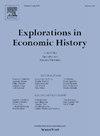The escape from hunger: The impact of food prices on well-being in Sweden, 1813–1967
IF 1.7
1区 历史学
Q1 ECONOMICS
引用次数: 0
Abstract
This study analyses how the standard of living for different social groups changed when Sweden developed from an agricultural to an industrial society and when the first steps towards a modern welfare society were taken. As a measure of living standards, we use the ability to overcome short-term economic stress caused by high food prices. We use individual-level longitudinal data from 1813 to 1967 for a rural/semi-urban area in southern Sweden with similar economic development, occupational structure, life expectancy and fertility to the country as a whole. We found that during the first part of the 19th century, when agriculture was reformed and grain became an export product, workers, but not farmers and other social groups, deliberately postponed births in response to rising food prices. Despite these efforts to maintain consumption, workers and their families suffered increased mortality risks during years of high food prices, indicating that they lived close to the subsistence margin and could not save to ensure consumption in bad times. In the second half of the 19th century, rising real wages improved workers’ living conditions and the mortality response to economic stress decreased. By the 20th century, as the economy progressed and welfare systems emerged, the mortality response disappeared entirely. In contrast, childbearing was still affected by economic cycles but now only during turmoil of the First World War and the 1918 influenza pandemic and not afterwards.
摆脱饥饿:1813-1967年瑞典食品价格对幸福的影响
本研究分析了当瑞典从农业社会发展到工业社会以及向现代福利社会迈出第一步时,不同社会群体的生活水平是如何变化的。作为衡量生活水平的一项指标,我们利用这种能力来克服高粮价造成的短期经济压力。我们使用了1813年至1967年瑞典南部农村/半城市地区的个人纵向数据,这些地区的经济发展、职业结构、预期寿命和生育率与整个国家相似。我们发现,在19世纪上半叶,当农业改革、粮食成为出口产品时,工人(而不是农民和其他社会群体)故意推迟生育,以应对不断上涨的食品价格。尽管为维持消费作出了这些努力,但在粮食价格高企的年份,工人及其家庭面临的死亡风险增加,这表明他们的生活接近维持生计的边缘,在困难时期无法储蓄以确保消费。19世纪下半叶,实际工资的上涨改善了工人的生活条件,经济压力导致的死亡率下降。到了20世纪,随着经济的发展和福利制度的出现,死亡率的反应完全消失了。相比之下,生育仍然受到经济周期的影响,但现在只是在第一次世界大战和1918年流感大流行的动荡期间,而不是之后。
本文章由计算机程序翻译,如有差异,请以英文原文为准。
求助全文
约1分钟内获得全文
求助全文
来源期刊

Explorations in Economic History
Multiple-
CiteScore
2.50
自引率
8.70%
发文量
27
期刊介绍:
Explorations in Economic History provides broad coverage of the application of economic analysis to historical episodes. The journal has a tradition of innovative applications of theory and quantitative techniques, and it explores all aspects of economic change, all historical periods, all geographical locations, and all political and social systems. The journal includes papers by economists, economic historians, demographers, geographers, and sociologists. Explorations in Economic History is the only journal where you will find "Essays in Exploration." This unique department alerts economic historians to the potential in a new area of research, surveying the recent literature and then identifying the most promising issues to pursue.
 求助内容:
求助内容: 应助结果提醒方式:
应助结果提醒方式:


